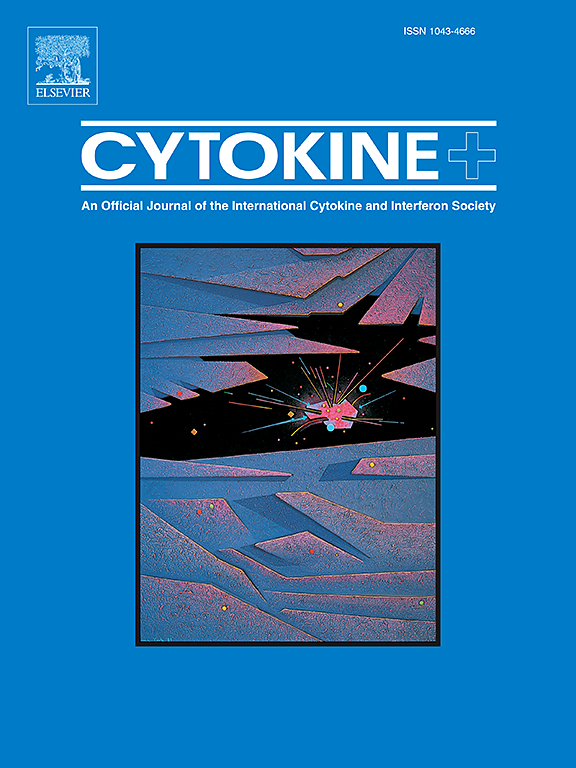从遗传学角度揭示全身性炎症调节因子与虚弱之间的因果关系。
IF 3.7
3区 医学
Q2 BIOCHEMISTRY & MOLECULAR BIOLOGY
引用次数: 0
摘要
研究目的以往的研究表明,全身性炎症与虚弱风险之间存在关联,但它们之间的因果关系仍未得到很好的证实。我们进行了一项双向孟德尔随机化(MR)分析,以研究全身炎症调节因子与虚弱之间的因果关系:与全身性炎症调节因子相关的遗传变异来自于对 41 种循环细胞因子(如白细胞介素-4(IL-4)、依他霉素和巨噬细胞炎症蛋白-1β(MIP1β))的综合遗传研究。我们整合了两项独立遗传研究中关于虚弱指数(FI)和弗里德虚弱评分(FFS)的虚弱汇总数据。采用逆方差加权法评估因果关系估计值。为评估估计值的稳定性,进行了敏感性和异质性分析。多重比较的P值调整采用了错误发现率(FDR)法:结果:MIP1β基因水平的升高和 eotaxin 基因水平的降低与 FI 的增加呈提示性相关(MIP1β:β = 0.016,Praw = 0.006,PFDR = 0.083; eotaxin: β = -0.030, Praw = 0.007, PFDR = 0.083) 和 FFS (MIP1β: β = 0.008, Praw = 0.027, PFDR = 0.247; eotaxin: β = -0.015, Praw = 0.014, PFDR = 0.247)。相比之下,遗传预测的 FI 与 IL-4 水平下降(β = -0.395,Praw = 0.040,PFDR = 0.638)和血小板衍生生长因子 BB(PDGF-BB,β = -0.385,Praw = 0.047,PFDR = 0.638)以及干细胞因子水平上升(SCF,β = 0.527,Praw = 0.005,PFDR = 0.204)密切相关。不同的敏感性分析也得出了类似的结果:本研究表明,MIP-1β水平升高和eotaxin水平降低可能导致更高的虚弱风险,而虚弱可能降低IL-4和PDGF-BB的水平,增加SCF的水平。本文章由计算机程序翻译,如有差异,请以英文原文为准。
Genetic insights into the causal linkage between systemic inflammatory regulators and frailty
Objectives
Previous studies have suggested the associations between systemic inflammation and the risk of frailty, but causal relationships between them remain not well established. We conducted a bi-directional Mendelian randomization (MR) analysis to investigate the causal links between systemic inflammatory regulators and frailty.
Methods
Genetic variants associated with systemic inflammatory regulators were obtained from a comprehensive genetic study on 41 circulating cytokines, such as interleukin-4 (IL-4), eotaxin, and macrophage inflammatory protein-1β (MIP1β). We integrated summary-level data on frailty from two independent genetic studies on frailty index (FI) and Fried frailty score (FFS). The inverse-variance weighted method was used to assess the causal estimate. Sensitivity and heterogeneity analysis was performed to evaluate the stability of the estimates. The false discovery rate (FDR) method was used for P value adjustment of multiple comparisons.
Results
Genetically elevated levels of MIP1β and decreased levels of eotaxin were suggestively associated with increased FI (MIP1β: β = 0.016, Praw = 0.006, PFDR = 0.083; eotaxin: β = -0.030, Praw = 0.007, PFDR = 0.083) and FFS (MIP1β: β = 0.008, Praw = 0.027, PFDR = 0.247; eotaxin: β = -0.015, Praw = 0.014, PFDR = 0.247). In contrast, genetically predicted FI was suggestively associated with decreased levels of IL-4 (β = -0.395, Praw = 0.040, PFDR = 0.638) and platelet-derived growth factor BB (PDGF-BB, β = -0.385, Praw = 0.047, PFDR = 0.638) and increased levels of stem cell factor (SCF, β = 0.527, Praw = 0.005, PFDR = 0.204). Similar results were obtained from different sensitivity analysis.
Conclusions
The present study demonstrates that increased MIP-1β levels and decreased eotaxin levels might lead to a higher risk of frailty, whereas frailty might reduce the levels of IL-4 and PDGF-BB and increase the levels of SCF.
求助全文
通过发布文献求助,成功后即可免费获取论文全文。
去求助
来源期刊

Cytokine
医学-免疫学
CiteScore
7.60
自引率
2.60%
发文量
262
审稿时长
48 days
期刊介绍:
The journal Cytokine has an open access mirror journal Cytokine: X, sharing the same aims and scope, editorial team, submission system and rigorous peer review.
* Devoted exclusively to the study of the molecular biology, genetics, biochemistry, immunology, genome-wide association studies, pathobiology, diagnostic and clinical applications of all known interleukins, hematopoietic factors, growth factors, cytotoxins, interferons, new cytokines, and chemokines, Cytokine provides comprehensive coverage of cytokines and their mechanisms of actions, 12 times a year by publishing original high quality refereed scientific papers from prominent investigators in both the academic and industrial sectors.
We will publish 3 major types of manuscripts:
1) Original manuscripts describing research results.
2) Basic and clinical reviews describing cytokine actions and regulation.
3) Short commentaries/perspectives on recently published aspects of cytokines, pathogenesis and clinical results.
 求助内容:
求助内容: 应助结果提醒方式:
应助结果提醒方式:


